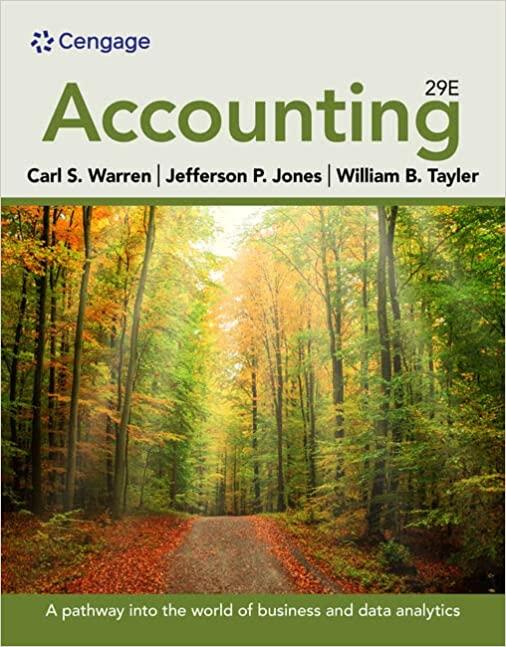Question
Part 1 Contribution Margin/Breakeven Chocolate Chip Sugar Specialty Total Units Sold 1,500,000 980,000 300,000 2,780,000 Sales $1,875,000.00 $882,000.00 $1,050,000.00 $3,807,000.00 Less: Variable Costs $690,000.00 $205,800.00
Part 1 Contribution Margin/Breakeven
| Chocolate Chip | Sugar | Specialty | Total | |
| Units Sold | 1,500,000 | 980,000 | 300,000 | 2,780,000 |
| Sales | $1,875,000.00 | $882,000.00 | $1,050,000.00 | $3,807,000.00 |
| Less: Variable Costs | $690,000.00 | $205,800.00 | $81,000.00 | $976,800.00 |
| Contribution Margin | $1,185,000.00 | $676,200.00 | $969,000.00 | $2,830,200.00 |
| Less: Common Fixed Costs | $125,000.00 | |||
| Profit | $2,705,200.00 | |||
| Per item Contribution Margin | $7.90 | $0.69 | $3.23 | |
| Weighted Average Contribution Margin | $1.98 | |||
| Break-even point in units | 63,158 | |||
Discuss the results based on your calculations as far as which type of cookie you think is the most profitable, which has the highest CM, etc.
Part 2 Full and Variable Costing
| Productions Costs: | ||
| Direct material | $0.60 | |
| Direct labor | $1.00 | |
| Variable manufacturing overhead | $0.40 | |
| Total variable manufacturing costs per unit | $2.00 | |
| Fixed manufacturing overhead per year | $139,000.00 | |
| In addition, the company has fixed selling and administrative costs: | ||
| Fixed selling costs per year | $50,000.00 | |
| Fixed administrative costs per year | $65,000.00 | |
| Selling price per cookie | $3.75 | |
| Number of cookies produced | 2,780,000 | |
| Number of cookies sold | 2,600,000 | |
| Full (absorption) costing : | ||
| Full cost per unit | $2.05 | |
| Ending Inventory Full (absorption) costing | $369,000 | |
| Variable costing : | ||
| Variable cost per unit | $2.00 | |
| Ending Inventory Variable costing | $360,000 |
Discuss the results, and comment on which method you think is more helpful to managers and why.
Part 3 Special Order
| Number of cookies needed | 1,000 |
| Discounted price per cookie | $2.75 |
| Normal price per cookie | $3.75 |
| Cost of special printed design per cookie | $0.50 |
| Cost of tool needed to make the design | $100.00 |
| Revenue for special order | $2,750.00 |
| Costs for special order: | |
| Design cost | $500 |
| Tool cost | $100 |
| Net increase (decrease) in profit | $2,150 |
Discuss the results and comment on if you think the cookie business should take on this special order of cookies for a wedding. Business has been slow the last few months, and the offer is less than the usual selling price for the cookies.
As part of your discussion, include both quantitative (based on the numbers) and qualitative (not based on numbers) factors that would go into the decision to take on the special order.
Part 4 Internal Rate of Return
| As the owner of the Cookie Business, you are considering the following investment: | ||||
| Purchase of new equipment | $250,000.00 | |||
| Expected annual increase in sales | $48,017.50 | |||
| Time frame | 7 | years | ||
| Acceptable rate needed | 9% | |||
| Calculate the Internal Rate of Return: | ||||
| PV of annuity factor | 5.2064 | |||
| Internal rate of return | 8% | |||
| Accept or reject | reject | |||
Discuss if you think the cookie business should accept or reject the purchase of the new equipment and why.
Additional information has come to your attention regarding the equipment purchase. One of the partner's brother owns the company that sells the equipment and insists the equipment is needed. Discuss any ethical concerns you see with this type of transaction.
Part 5 Cash Budget
| The budgeted credit sales are as follows: | ||||
| December last year | $250,000 | |||
| January | $125,000 | |||
| February | $300,000 | |||
| March | $90,000 | |||
| Collection: | ||||
| Month of the sale | 80% | |||
| Month following the sale | 20% | |||
| Estimated cash receipts | ||||
| January | February | March | ||
| Last month's sales | $50,000 | $25,000 | $60,000 | |
| Current month's sales | $100,000 | $240,000 | $72,000 | |
| Total | $150,000 | $265,000 | $132,000 |
Discuss your observations about the way cash is collected if the company needs $150,000 per month for expenses.
Part 6 Material and Labor Variance
| Actual Cost of Direct Materials | $225,000 | ||
| Standard Cost of Direct Materials | $224,800 | ||
| Actual Materials Used | 30 | ||
| Standard Materials Used | 31 | ||
| Actual Direct Labor Rate | $15.50 | ||
| Standard Labor Rate | $15.00 | ||
| Actual Hours Worked | 45 | ||
| Standard Hours Worked | 40 | ||
| Amount | Favorable/ Unfavorable | ||
| Calculate Materials Variances: | |||
| Materials Price Variance | 7,451.61 | unfavorable | |
| Materials Quantity Variance | 7,251.61 | favorable | |
| Calculate Labor Variances: | |||
| Labor Rate Variance | $22.50 | unfavorable | |
| Labor Efficiency Variance | $75 | unfavorable |
Discuss your observations about the variances and ways to plan to improve any of the variances.
Step by Step Solution
There are 3 Steps involved in it
Step: 1

Get Instant Access to Expert-Tailored Solutions
See step-by-step solutions with expert insights and AI powered tools for academic success
Step: 2

Step: 3

Ace Your Homework with AI
Get the answers you need in no time with our AI-driven, step-by-step assistance
Get Started


